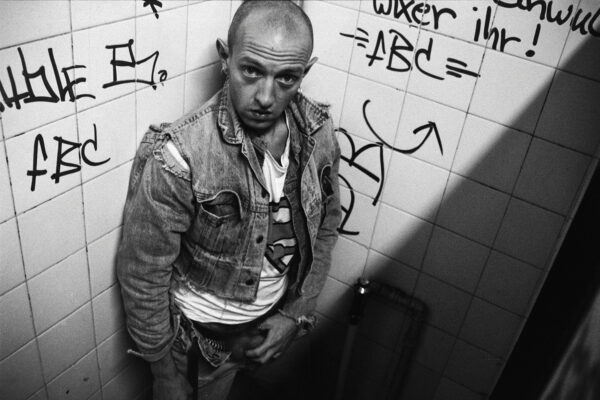
I often wonder about what the creative landscape of the planet would look like if all the artists who have died from AIDS had survived. The energy of people like Derek Jarman, Leigh Bowery, Klaus Nomi, Robert Mapplethorpe, Keith Haring – the list is endless – is so missed.
Another artist to add to this list is Juergen Baldiga, the subject of a fantastic new documentary Baldiga – Unlocked Heart, which screens again at the BFI Flare Film Festival this Saturday.
Baldiga was born in Essen, Germany in 1959. By the age of 15 he was turning tricks at Essen railway station. Aged 20, in 1979, he moved to West Berlin and fully embraced the city’s legendary queer nightlife. He was bold, handsome, sexy, with a big dick, and ran with a cool hedonistic crowd. He funded his life with sex work and also worked as a chef. He wrote poetry and kept detailed written diaries of his adventures. Life was beautiful, the sex was wild and Berlin’s queer nightlife knew no boundaries.
 This golden period in the city’s history ended abruptly in 1982 when the dark shadow of the AIDS pandemic arrived in the city. One by one, people on the queer scene around Baldiga started getting sick and dying. In 1984 Baldiga himself received a positive HIV diagnosis. Back then a sink or swim mentality was triggered in most people receiving positive HIV test results. Baldiga chose to swim and had even more sex and wild times than before, as well as developing his talent as a photographer. He wanted to document the underworld around him and created a fantastic archive of work featuring his friends, lovers, sex positivity, street life and the drag queens from SchwuZ Club, his chosen family. His work reminds me of the unpolished elements of work by Nan Goldin and Robert Mapplethorpe. He also recorded the onslaught of the HIV horror show around him, including the effects of the disease – then largely untreatable – on his own body and soul. Baldiga also became an AIDS activist. He was public about his HIV status in the press and on TV at a time when very few other people were out about it. When he died in 1993, he left behind dozens of diaries and thousands of photographs which document a unique person and period in the city’s history.
This golden period in the city’s history ended abruptly in 1982 when the dark shadow of the AIDS pandemic arrived in the city. One by one, people on the queer scene around Baldiga started getting sick and dying. In 1984 Baldiga himself received a positive HIV diagnosis. Back then a sink or swim mentality was triggered in most people receiving positive HIV test results. Baldiga chose to swim and had even more sex and wild times than before, as well as developing his talent as a photographer. He wanted to document the underworld around him and created a fantastic archive of work featuring his friends, lovers, sex positivity, street life and the drag queens from SchwuZ Club, his chosen family. His work reminds me of the unpolished elements of work by Nan Goldin and Robert Mapplethorpe. He also recorded the onslaught of the HIV horror show around him, including the effects of the disease – then largely untreatable – on his own body and soul. Baldiga also became an AIDS activist. He was public about his HIV status in the press and on TV at a time when very few other people were out about it. When he died in 1993, he left behind dozens of diaries and thousands of photographs which document a unique person and period in the city’s history.
Director Markus Stein, together with writer Ringo Roesener, have painstakingly gone through Baldiga’s vast archive to creative a very special documentary. It’s rare to witness the life and death of an AIDS sufferer documented in such visual detail. Derek Jarman told a similar story of his AIDS journey but his work was more written than visual. Stein’s candid film combines brilliant, very sexy imagery, spoken excerpts from Baldiga’s diaries and poems, reconstructed scenes from nightclubs, and interviews with Baldiga’s friends and lovers to tell a story that’s both fabulous and harrowing. AIDS doctors and nurses who treated patients in Berlin back then give heartfelt interviews, the horror of what they had to deal with still evident in their faces over thirty years later. Many of the medics working with patients then were gay and/or HIV positive themselves and often ended up treating people they knew, always with the sinking background feeling that what was happening to the people in the ward around them might happen to them too soon. Other interviewees include Baldiga’s last boyfriend, the handsome Ulf Reimer, one of his sisters and drag performer Timo Lewandovsky. A gentle electronic soundtrack by Manuela Schinina and Eike Hosenfeld adds to the poignancy of the film, especially when combined with a voiceover in Baldiga’s voice. As well as the personal history, Stein’s film is also an important record of Berlin’s queer life from 1979 – 1993, a period that hasn’t been recorded in detail before. Baldiga documented his physical and mental downfall right up until his decision to take his own life in 1993. This is often distressing viewing – bring tissues – tempered only by the love he had with Ulf, who was his solid companion right until the end.
Many queer people born after 1990, so those aged 34 and under today, have little idea of how horrific the 1980s and early 1990s were for those dealing with the AIDS virus. In some ways this is a welcome effect of the success of current HIV treatment options. It’s also, however, a crucially important part of queer history that shouldn’t be forgotten. Stein’s film serves to address that. A beautiful, heart-breaking film that everyone should see.

Queerguru’s Contributing Editor Ris Fatah is a successful fashion/luxury business consultant (when he can be bothered) who divides and wastes his time between London and Ibiza. He is a lover of all things queer, feminist, and human rights in general. @ris.fatah

